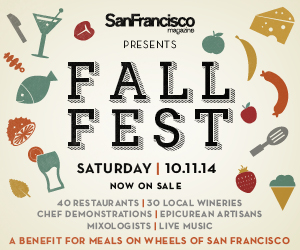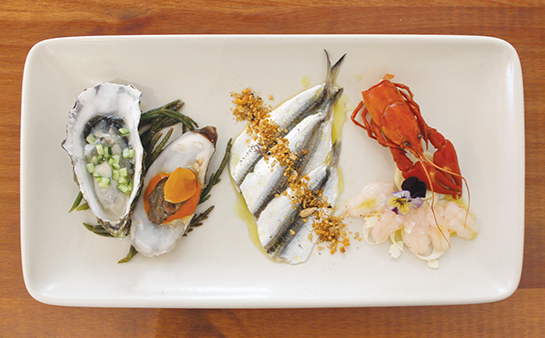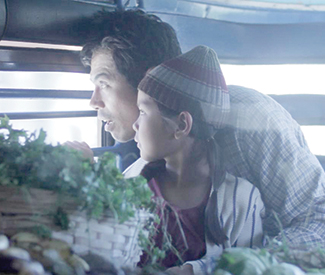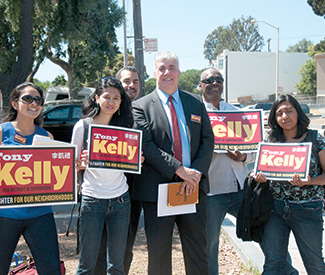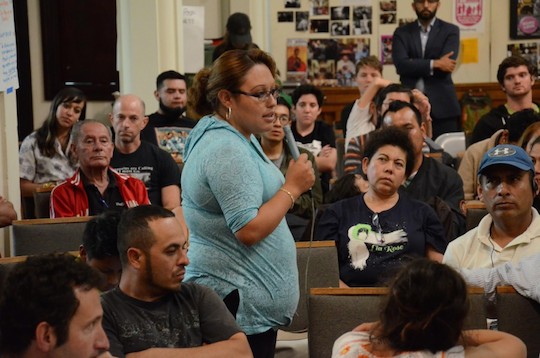Film listings are edited by Cheryl Eddy. Reviewers are Kimberly Chun, Dennis Harvey, Lynn Rapoport, and Sara Maria Vizcarrondo. For rep house showtimes, see Rep Clock.
OPENING
Dolphin Tale 2 The heroic dolphin with the prosthetic tail returns for more aquarium adventures in this family drama starring Harry Connick, Jr., Ashley Judd, Morgan Freeman, and Kris Kristofferson. (1:48)
The Drop The late James Gandolfini gets a fitting final feature-film sendoff in this edgy microcosm of a crime movie, set among the small-time hoodies of Brooklyn, but just easily recast in Tony Soprano’s Jersey or the Beantown of 2010’s The Fighter. As Cousin Marv, a onetime dive-bar owner forced to turn his watering hole over to Chechen mobsters as a drop spot for bookmaking loot, he also gets worthy sparring partners in Tom Hardy and Matthias Schoenaerts (star of 2011’s Bullhead, director Michaël R. Roskam’s Oscar-nominated breakout). Hardy’s Bob looks to be the perpetual side guy to his Cousin Marv; he seems sludgy and lacking confidence, until he finds a battered pit bull puppy in a trashcan belonging to Nadia (Noomi Rapace) — and discovers himself in the middle of a brazen robbery at the drop bar. With the puppy and Nadia comes the canine’s purported owner, rumored killer, and neighborhood “nut case” Eric (Schoenaerts). The beauty of Dennis Lehane’s screenplay, spinning off his short story “Animal Rescue,” is embedded in how the most banal niceties (like “Good to see you”) are used with Mamet-like skill to signal the threadbare facade of civilized behavior and convey an almost nihilistic sense of imminent threat. Meanwhile, Roskam walks a tightrope between the drab, wintry everyday and a pervasive mood of menace, creating a downbeat yet almost horrifying effect when the trigger is finally pulled — and the veil between the hidden and the real, the animal and the human, is dropped. (1:45) (Chun)
God Help the Girl Perhaps it’s not subtle that the first words we hear in the indie pop musical God Help the Girl — the writing and directing debut of Stuart Murdoch, Belle and Sebastian’s lead singer–songwriter — come out of the mouth of a DJ, evoking Nick Drake, no less, in a riff about the mystique of dead musicians. The influences and aesthetic of Murdoch and the beloved Scottish chamber pop group float through the film, a sort of moody live-action manifestation of 15-plus years’ worth of Belle and Sebastian albums. We hear the DJ through the headphones of our nervy, melancholy heroine, Eve (Emily Browning, of 2011’s Sleeping Beauty), a young Australian living in Glasgow, whom we first meet narrating in song her night flight from a psychiatric institution, where she’s under care for anorexia. Music keeps her moving, to a rock club, for starters, where she watches a band awkwardly implode and befriends the guitarist, James (Olly Alexander), who introduces her to aspiring musician Cassie (Hannah Murray), who reckons they should start a band. Easily half of the movie, and the better half, is told in song — largely by Eve, a talented songwriter with a sweetly captivating voice. The songs, written by Murdoch over the last decade, feel lush and fully realized, and pull us along through the story in infectiously giddy and affecting interludes, but tend to drop us off in vague, meandering terrain, among agreeable but sketchy acquaintances, when they end. (1:51) Roxie. (Rapoport)
Last Weekend Celia Green (Patricia Clarkson) is the matriarch of a clan gathering to spend a now-rare weekend at their Lake Tahoe vacation home — the last of the summer, and perhaps the last ever, as she and fitness-tycoon spouse Malcolm (Chris Mulkey) are considering selling it. This news is sure to upset their grown sons, even if neither spend much time here anymore. But then, what doesn’t upset them? Roger (Joseph Cross) constantly snipes at mom, no doubt to let off steam from some as-yet-unbroken news of his own about an embarrassing blunder made in his financial-sector job. Theo (Zachary Booth) is just generally hypersensitive, about his own feelings if no one else’s, including the kinda-sorta-boyfriend of the fleeting moment (Devon Graye) he’s dragged here, along with several coworkers from the TV sitcom he works on as a low-rung writer. Other characters include the married groundskeeper and housekeeper (Julio Oscar Mechoso, Julie Carmen) everyone treats with elaborate familiarity as “almost family,” and Roger’s longtime girlfriend (Alexis Rasmussen), who’s very aware that she is not considered family. Presided over by Celia, who sees herself as an unpretentious Earth Mother but is in fact a meddling perfectionist, the Greens are an exasperating lot of self-absorbed, mutually unsupportive brats. Tom Dolby and Tom Williams’ seriocomedy is willing to point out their foibles and chuckle, but not to actively criticize (let alone satirize) them. Instead, we’re ultimately expected to care about these shallow, catty figures of under-appreciated privilege — an emotional connection the movie never remotely earns. If you’re going to make a movie about Rich People Problems, it had better have a lot more bite than this one manages. (1:34) Vogue. (Harvey)
The Man on Her Mind Little wonder that this comedy about a woman who prefers an adult version of an imaginary friend to real-life suitors feels so hermetically sealed: writer and Soho Press co-founder Alan Hruska co-directs (with Bruce Guthrie) this hardly filmic version of his play, starring its original UK cast. All assembled wrap careful NYC accents around Hruska’s verbiage, which takes center stage in this overtly theatrical, very talky — albeit not especially witty — vanity indie. Bookish publishing staffer Nellie (Amy McAllister) possesses the seemingly enviable life of an independent working woman in NYC, until one finds out, through naggy sister Janet (Georgia Mackenzie), that Nellie’s slick supposed beau (Samuel James) is not all he’s cracked up to be. Though Hruska dallies with some intriguing ideas about the way we idealize, project upon, and even create our love objects, this cinematic realization feels as sophomoric and long-winded as an undergraduate seminar. (1:38) Opera Plaza. (Chun)
Metro Manila See “Urban Decay.” (1:40) Roxie.
My Old Lady If only the grand dame had more of a say, rather than the whiny, middle-aged offspring. Playwright Israel Horovitz makes his feature-film debut, directing his own play in this potentially fascinating clash of cultures on a generational battlefield populated by some amply endowed acting talents. New Yorker Mathias (Kevin Kline), who grew up privileged with a “silver knife” in his maw, got little else from his deceased, estranged father than a Paris apartment in the coveted Marais district. But his real estate dreams are quashed when it turns out to be a “viager,” a quirk of French law that allows the former owner — in this case, worldly elder Mathilde (Maggie Smith) — to continue dwelling in the property long after the sale, collecting monthly payments from the purchaser until her death. Penniless, troubled Mathias can barely afford those payouts, much less cope with Mathilde’s daughter, Chloe (Kristin Scott Thomas), in this wearily paced dramedy that turns out to be more sour — and dourily serious — than saucy. One is forced to fantasize: What would Smith’s Violet Crawley do, or better yet, say, about this effort, which makes Downton Abbey look like the picture of crisply edited moviemaking modernity? (1:47) Clay. (Chun)
No Good Deed A sinister man (Idris Elba) terrorizes a mother (Taraji P. Henson) and her kids in this crime thriller, helmed by Elba’s frequent Luther director Sam Miller. (1:24) Shattuck.
The Pirates Beautiful, badass pirate Yeo-wol (Son Ye-jin) leads a mutiny against her ship’s cruel captain (Lee Geung-young) at sea. Meanwhile, on land, an outspoken soldier (Kim Nam-gil) battles his own cruel commander (Kim Tae-woo) before escaping into the hills and remaking himself as a semi-successful bandit known as “Crazy Tiger.” These worlds crash together in Lee Seok-hoon’s lavish CG extravaganza, set during a time in Korea’s history when leadership was so unstable, the loss of a royal seal could mean certain chaos — and it does, when a whale gobbles up said golden symbol when it topples overboard. Racing to retrieve it, for various reasons, are the four parties described above, with cross-clashes between all involved. There are savage sword fights; explosive chase scenes through seaside villages; hair and make-up that would make Captain Jack Sparrow swoon (and exaggerated acting that makes latter-day Johnny Depp look subtle); fiercely denied romantic attractions; heroes diving away from explosions and villains howling to the heavens; and epic arguments over which brand of outlaw — pirate or bandit? — is tougher. Very silly indeed. But also, it must be said, very fun. (2:09) Century 20 Daly City. (Eddy)
Second Opinion The emphasis should be on “Opinion” in the title of this doc directed by Burzynski (2010 and 2013) maker Eric Merola, who seems to be building a career on movies about cancer-treatment controversies. Here his hero with an ax to grind is Ralph W. Moss, a science writer working in public relations at Memorial Sloan-Kettering Cancer Center in the ’70s, who discovers a cover-up concerning laetrile research. The single-source effect, however, of relying primarily on Moss’ on-camera interviews to carry this project — and the lack of current voices willing to weigh in with, surprise, second opinions — makes it feel less like a fully-realized, thoughtfully-balanced film and more like a inadequately reported TV newsmagazine segment. (1:15) Roxie. (Chun)
The Skeleton Twins See “Falling Apart Together.” (1:33)
Take Me to the River Memphis is a battered, gracious lady of a music town and she deserves her due, though she doesn’t get it in this well-meaning yet unfocused doc in need of a deep edit. Directed by veteran musician-turned-filmmaker Martin Shore, Take Me to the River lifts its name from a song by the otherwise-ignored Memphis denizen Al Green and hangs its hat in the city so pivotal in the birth of the blues, R&B, soul, and rock ‘n’ roll, under the pretense of witnessing the making of an album that brings together music makers new and old. Among them are unsung lights like songwriter William Bell and guitarist Charles “Skip” Pitts, icons like Bobby “Blue” Bland, and rappers (including Snoop Dogg). Overseeing the project are North Mississippi Allstars band mates and brothers Luther and Cody Dickinson, in tribute to their dad, producer Jim Dickinson. We do get a taste of the love, respect, and long history between, say, Mavis Staples and the Dickinson brudders, but somewhere along the way, River removes itself away from the making of the record and gets drawn into the dramatic vortex centered on the rise and tragic fall of Stax Records, intertwining it with the Civil Rights era — although considering the muddy explication surrounding the label’s demise, Shore appears ill-equipped to piece out its tale. Mucking it up further are sporadic appearances by star narrator Terrence Howard, whose weak smooth-jazz performance is given way too much play. (1:35) Embarcadero, Shattuck, Smith Rafael. (Chun)
ONGOING
As Above, So Below (1:40) Metreon, 1000 Van Ness.
Boyhood Believe the hype: Richard Linklater’s Boyhood is one of the best films of the year. It’d be a towering cinematic accomplishment in any year. By now, you’ve heard the set-up, which borrows elements from Linklater’s Before films, as well as his coming-of-age dramas (1993’s Dazed and Confused in particular). He filmed his cast — including titular youth Ellar Coltrane, Lorelai Linklater as his older sister, and Patricia Arquette and Ethan Hawke as his divorced parents, on and off over 12 years — with scenes touching on moments both monumental (high-tension moments with ugly stepfathers) and microscopic (the creation of a perfect campfire s’more). The years flow by, signaled not by any obvious gestures like on-screen text, but by changing hairstyles, pop culture references, and evolving video-game consoles. Watching Coltrane’s Mason grow from arrowhead-obsessed tyke to thoughtful college freshman is a rare and remarkable pleasure; among the more experienced actors, Arquette is particularly moving as a fiercely loving single mom determined to advance in her career despite continual, mountain-sized roadblocks in her personal life. (2:40) Embarcadero, 1000 Van Ness, Sundance Kabuki. (Eddy)
Calvary John Michael McDonagh made a splashy cinematic entree both writing and directing 2011’s acerbic The Guard, which starred Brendan Gleeson as a willfully perverse small-town cop. Filmmaker and actor are back with Calvary, a film just as good, in which Gleeson’s priest is the discreetly gruff moral center of a coastal Irish hamlet that surely would have none otherwise. His parishioners are all skeptics, heretics, nonbelievers, and blatant sinners — cast members include Chris O’Dowd, Aidan Gillen, and Brendan’s real-life son Domnhall — who take particular pleasure in ridiculing the uprightness of this one man no one has a legitimate gripe against, save resentment. As if all this weren’t enough, at Calvary‘s start, an unseen confessor tells James he was abused for years by a (now-dead) Catholic priest, and as recompense will kill his current, admittedly blameless confessor in a week’s time. This set-up would appear entirely, absurdly skewed if not for the gravitational center Gleeson provides; he single-handedly provides the sincere if faint hope of redemption in a scenario that otherwise provides every possible indication of damnation for all. Calvary centrally addresses the question of faith while ultimately dodging the answer. I’d appreciate McDonagh’s ambivalence more if he weren’t quite so pleased about it. He’s got extraordinary taste, no doubt — from its editorial pace to its costume and soundtrack choices, this movie is curated within an inch of too-much-ness. But beyond his understandable disillusionment with the Catholic Church’s crimes, does he truly care about morality, or is it just an authorial chew-toy? (1:45) Sundance Kabuki. (Harvey)
Chef Not to take anything away from the superhero crew, but Chef feels like the closest thing to a labor of love from writer, director, and star Jon Favreau in many a day. As a director, he may have been making doughnuts — fun-filled and teeming with CGI eye candy, but doughnuts nevertheless — when it came to effects-driven blockbusters like 2008’s Iron Man, but this well-meaning play for the heart, by way of the stomach, shows you where Favreau’s head is really at. Chef revolves around Carl Casper (Favreau), a onetime food star, now reduced to serving up predictable crowd-pleasers at the behest of his restaurant’s overbearing owner (Dustin Huffman). It takes the barbs of an influential critic (Oliver Platt) — and an ensuing Twitter war — to set Carl off and send him away on his own, at the coaxing of his glam ex Inez (Sofia Vergara). Hooked up with a dilapidated food truck and former kitchen staffer Martin (John Leguizamo), and aided by ably Tweeting son Percy (Emjay Anthony), Carl ties his dreams — and lost passion — to the classic Cuban sandwich. The ensuing road trip from Miami to LA, and Carl’s journey toward self and a renewed relationship with his son, is a fun (if, in the end, a bit too speedily sketched) vault through the joys of eating your way through America’s new culinary heartland. Amid the volley of sign-of-the-times social-media swinging and cameos by the uncostumed Robert Downey Jr., Scarlett Johansson, and the like, Favreau’s main dish is that a family that eats, cooks, and runs a business together, stays together — child labor laws or no. (1:55) SF Centre, Sundance Kabuki. (Chun)
Dawn of the Planet of the Apes As usual, a heady hybrid of anticipation and dread accompanies all Planet of Apes installments: you brace yourself for the abused, righteously rebellious apes; the apocalyptic mise-en-scène laden with symbolism; and more overt messaging concerning animal testing, civil rights, and gun control. But why worry? In line with 2011’s Rise of the Planet of the Apes, the PG-13 high-fives go to new Apes director Matt Reeves (2008’s Cloverfield) for sparing us animal kills, gore, and graphic violence, despite its Dawn of the Dead-evoking title. Really, this Dawn is all about the bitterly fought beginnings of a civilization among the primates north of the Golden Gate Bridge in Muir Woods, complete with community building, social structure, and alas, a burgeoning war with the humanoids amid vaguely familiar SF ruins, setting off an epic showdown that challenges not only the oft-repeated commandment “ape shall not kill ape” but takes advantage of our anthropomorphized pals’ ability to swing with the C4 explosions. The viral drug ALZ 113 that led to super-intelligent primates like chimp hero Caesar (motion-captured Andy Serkis) has decimated the human population, leaving the field wide open for enterprising and vengeful creatures like scarred lab survivor Koba (motion-captured Toby Kebbell). Neither quite trusts the band of desperate human survivors — including friendly Jason Clarke, nurturing Keri Russell, and token asshole Kirk Acevedo — that ventures into the apes’ woods to harness the power of nature, namely a dam, to electrify their SF compound. You know what side of the evolutionary span we’re on when the humans seem much more interchangeable than the chimps, and the movie can barely wait to end on its contemporary version of a Touch of Evil (1958) crane shot, as it zooms to an extreme close-up of a certain chimp’s carefully crafted eyes. (2:10) Metreon, 1000 Van Ness. (Chun)
The Expendables 3 Patrick Hughes — the guy tapped to helm the remake of 2011’s The Raid — directs a cast of thousands (more or less) in this third installment of Sylvester Stallone’s retro action franchise. By now, the Expendables movies have their formula down, not that it was particularly original to begin with, and all the marks are duly hit in part three: sinister bad guy (Mel Gibson — a solid choice, since who doesn’t love to hate him?) angers mercenary Barney (Stallone) and his team of graying, gun-wielding, shit-talking badasses (Jason Statham, Dolph Lundgren, Randy Couture, and Terry Crews). Revenge is sought, bullets fly, buildings explode, a government operative sticks his nose in (here, it’s Harrison Ford), and Arnold Schwarzenegger shows up to save the day. Fortunately, Expendables business as usual also happens to be stupidly enjoyable, especially with the addition of a just-out-of-prison (onscreen and off) Wesley Snipes. There are also fun roles for Antonio Banderas, Kelsey Grammar, and Robert Davi, but the crew’s next-generation recruits (rebel Kellen Lutz, hacker Glen Powell, weapons master Victor Ortiz, and ladybro Ronda Rousey) seem rather unnecessary. Isn’t the point of these movies to remind us that old guys still rule? (2:07) Metreon. (Eddy)
Frank Who doesn’t want to be a musical savant, visually riveting, naturally gifted, freed from convention, and liberated of linear thought? The exception might be the doll-headed, damaged namesake of this comedy loosely inspired by the life of late English musician and comedian Frank Sidebottom (real name: Chris Sievey), and real-life Sidebottom sideguy Jon Ronson, who co-wrote the screenplay. And if this loving, very funny, bromantic take on the so-called creative process of rock seems a bit forced at times, that’s only because the movie is so clearly filtered through the archetypal wannabe, made likable by Domhnall Gleeson. His office worker Jon is struggling to write songs when he stumbles across a band, Soronprfbs, after watching their keyboard player attempt to drown himself at the beach. Manager Don (Scoot McNairy) taps the bystander to contribute to the chaos happening onstage, then drags him off for the making of the album. Mysterious leader Frank (Michael Fassbender), who never takes off his massive, faux-happy head, finds inspiration in threads protruding from upholstery. As Jon’s nest egg gets sucked into the recording budget and theremin player Clara (Maggie Gyllenhaal) rages against the interloper, he posts the band’s, er, artistry to YouTube, obtaining the group a coveted gig at South by Southwest. But who really wants this shot at fame? The sideman with a will to power, or the damaged true talent? Director Lenny Abrahamson and Ronson wisely place Frank squarely in the viral video/GIF/Vine-poisoned multiplatform miasma of today, put across all the more powerfully by Gleeson and particularly Fassbender, who reveals a fine singing voice. While cleverly referencing outsider artists big and small by way of right-on original songs by Stephen Rennicks, Frank asks vital questions about motivation and art-making in an era when it seems like everyone is getting their 15 minutes of fame — and we’re getting increasingly weary of eyeballing it and filtering the wheat from the gone-in-a-nanosecond chaff. Some make music because they want to be stars, while others, Frank says, do it because they have little other choice. (1:34) Opera Plaza. (Chun)
The Giver Lois Lowry’s classic YA novel gets a veteran helmer for its big-screen adaptation, but Philip Noyce’s ability to attract top adult talent (Meryl Streep, Jeff Bridges) can’t outweigh his heavy-handed interpretation of what was never a subtle work to begin with. In a vaguely post-apocalyptic society so regulated and dulled that nobody has emotions or empathy, a young man named Jonas (Maleficent‘s Brenton Thwaites, bumped up in age from the book’s 11-year-old) is tasked with becoming the “receiver of memories.” Basically this means that he gets to hang out with Bridges’ character and learn things about the world and human history in the form of Koyaanisqatsi-meets-National Geographic montages (music — it’s a thing! Also: war is hell, etc.) This is life-changing stuff, but part of the deal is that he must never, ever tell anyone else about it, at least until he’s as grizzled as Bridges and has his own successor in need of a thorough mind-blowing. Of course, he immediately loops in pretty BFF Fiona (Odeya Rush), who he’s been seeing in a new light since catching wind of a concept called “love.” Soon, his awakening draws the ire of his mother-esque guardian (Katie Holmes), as well as the community’s leader (Streep). If you’re looking for suspense, or any curve balls (duuuude … once Jonas’ mind starts expanding, he starts seeing the black-and-white world in color!), best backtrack to one of Noyce’s 1990s thrillers (1992’s Patriot Games, perhaps). About the only surprise in The Giver is that Taylor Swift’s much-hyped role is smaller than expected, and not nearly as distracting. (1:40) 1000 Van Ness, SF Centre. (Eddy)
Guardians of the Galaxy The trailer that nearly broke the internet didn’t lie: Guardians of the Galaxy is cheeky, hilarious, eye-popping fun. Its plot may be a predictable anti-hero’s journey, but the saga of Peter “Star-Lord” Quill (Chris Pratt), half-Earthling, half maybe-alien, as he transforms from scavenging scoundrel to rescuer-of-the-universe is so enjoyable nobody seeking a good time at the movies will care. Helping Quill in his battle against baddie Ronan (Lee Pace) are slinky, green-skinned Gamora (Zoe Saldana); rascally raccoon Rocket (voiced by Bradley Cooper); muscle-bound dim bulb Drax (former pro wrestler Dave Bautista); and a tree-like creature named Groot (voiced by Vin Diesel — his best performance in years, if ever, despite the fact that the only words the character ever utters are “I am Groot.”) Director and co-writer James Gunn (2010’s Super), working from a cult comic from the prolific house of Marvel, does a stellar job balancing action and goofiness, with plenty of unexpected touches along the way, including the best use of 1970s soft-rock since Reservoir Dogs (1992) and Cherish (2002). (2:02) Metreon, 1000 Van Ness, Sundance Kabuki. (Eddy)
The Hundred-Foot Journey Don’t watch Lasse Hallström’s latest film on an empty stomach. Under the film’s rich layers of mouthwatering food closeups and stunning shots of France (which, admittedly, occasionally threaten to steal the show), The Hundred-Foot Journey is a simple feel-good movie, akin to your favorite comfort food. The Kadam family spices up the South of France when they open an Indian restaurant just 100 feet away from a formidable competitor: a ritzy place owned by Madame Mallory (Helen Mirran). Papa (Om Puri) and eldest son Hassan (Manish Dayal) don’t back down when the heat gets turned up. It’s easy to get caught up in Hassan’s optimism, so the film is predictable (even managing to sprinkle a bit of romance in), but not cheesy. The score is the final icing on the cake, but it’s impossible to expect anything less from Slumdog Millionaire (2008) composer A.R. Rahman. (2:02) Balboa, 1000 Van Ness, SF Centre, Sundance Kabuki. (Amy Char)
If I Stay Place If I Stay alongside The Fault in Our Stars, and wonder: Is the time right to begin to define the tweepie, or teenage weepie? If I Stay speaks to the emo girl snifflers and intimate tween dystopians in the crowd, though it’s not compelling enough to make them forget to check their texts mid-movie. Excruciatingly shy cello prodigy Mia (Chloë Grace Moretz) is the oddball in her happy rocked-out family (mom and dad are Mireille Enos and Joshua Leonard). Her underlying, relatable dilemma: Should she should reach for her Juilliard dreams or stick close to her Portland, Ore., home to be with her own budding rock star boyfriend Adam (Jamie Blackley, he of the dilated wooden gaze)? But fate intervenes, as a head-on car accident slams Mia into a coma and into an out-of-body battle over deeper questions concerning survival, identity, or simply, as her punk drummer dad might quip, should she stay or should she go? Further, how to depict this without reducing Mia’s out-of-body spirit to Alice in Flashbackland, sprinting comically through hospital halls? One would think she’d run into a stray family member or two on their way to the light, but alas, If I Stay never rises to the occasion — or imaginative possibilities — and its multiple flashbacks and disembodied interludes add an ungrounded, talky sheen to the overall earnestness. Perhaps unfairly, the efforts by documentarian R.J. Cutler, working with Gayle Foreman’s popular YA novel, pale in comparison to, say, the far more psychedelic Enter the Void (2009), with its traumatic crash crash, shattered family, and wandering protagonist. Unlike that film, however, there’s never any question where If I Stay‘s heart lies: In the all-too-familiar construct of suburban America, rather than an ecstatic afterworld. (1:47) 1000 Van Ness, SF Centre. (Chun)
The Identical I love sinking my incisors into a meaty Elvis Presley fantasy as much as the next rock ‘n’ roller, but the collision of semitransparent ulterior motives and agendas going down in this off-key independent ain’t nothing but distracting. What if the Pelvis’s twin brother had lived? What if an earnest impersonator turned out to be something more than a great pretender? How does Christianity stand alongside Zionism — or the power of the King beside the potency of a pathetic wig? Here, Ryan Wade (Blake Rayne, aka Elvis impersonator Ryan Pelton) has a fire burning within for proto-rock, blues, R&B, and honkytonk — he’s just not cut out to follow in the footsteps of his passionate preacher dad Reece (Ray Liotta). Instead, help from his drummer friend Dino (Seth Green) and encouragement from his dream-girl-turned-perfect-wife Jenny (Erin Cottrell) leads the earnest Ryan to enter a tribute contest dedicated to the late-period-Elvis-esque Drexel “The Dream” Hemsley (also played by Rayne). Is it a coincidence that Ryan so closely looks and sounds like Drexel? Despite the good faith acting chops brought to the enterprise by Liotta, Ashley Judd, and Joe Pantoliano, the effort is largely wasted, thanks to a flabby script by pop fantasist Howard Klausner, stale music-biz play-by-plays by first-time director Dustin Marcellino, and the painfully non-period, poorly written music and off-point production. When the ’60s-era “Dream” — not to be confused with The-Dream — croons a tune that’s closer in style to ’80s Lionel Richie than “Can’t Help Falling in Love,” rock’s true believers will be scratching their noggins in disbelief, wondering why anyone would even bother making a Cross and the Switchblade version of the Elvis myth. (1:47) Metreon, 1000 Van Ness. (Chun)
Innocence (1:36) 1000 Van Ness, SF Centre.
The Last of Robin Hood Richard Glatzer and Wash Westmoreland’s The Last of Robin Hood is one of those movies that should be great, given the material and talent on tap, but instead falls flat for nearly intangible reasons. For much of his career, movie star Errol Flynn (Kevin Kline) flourished in a series of Westerns, war movies, and exotic adventures, until audiences tired of his ever-more routine exploits — and the highly public roué reputation that ballasted them offscreen. Late in his life, he met aspiring dancer-singer-actor Beverly Aadland (Dakota Fanning). According to this film’s version of events, he’d already seduced her before realizing that she was actually just a very precocious 15-year-old — carefully groomed to look older by Florence Aadland (Susan Sarandon), a onetime dancer who projected her own ambitions on her daughter. When Mrs. Aadland realizes that their relationship is hardly innocent, she’s furious. But she’s vain and flattered enough to fall for the star’s charm offensive. Kline is a resourceful actor whose characterization is ingenious and layered, but it still falls into that category of celebrity impersonation, which always feels a bit like a clever stunt. (He’s somewhat upstaged by Sarandon, who nails the comedy and pathos of terminal celebrity aspiration.) The Last of Robin Hood also feels constrained budget-wise — and while you can get the heady mixture of glamour, melancholy, barbed humor, and romance that the writer-directors were going for, it always falls a little short. As with so many Hollywood biopics, a great real-life story feels diminished onscreen, the legend still more potent than the dramatized re-creation. (1:30) Embarcadero, Sundance Kabuki. (Harvey)
A Letter to Momo Morbid obsessions — and the ghouls and goblins of Japanese ghost stories — are rarely as sweet as they are in A Letter to Momo, the second hand-drawn animated film directed by Hiroyuki Okiura (1999’s Jin-Roh: The Wolf Brigade). Shy tween Momo is tagging along on her mother’s journey home to an island on Japan’s Inland Sea, but even that remote, beauteous locale can’t dissipate Momo’s sorrow and guilt about the death of her father, who she fought with just before he passed. She doesn’t realize that she’s being followed as well — by three water droplets or spirits that assume the grotesque forms of an Edo-era ghostly manga. Only Momo can see and hear these mischievous, forever-hungry visitors, who put the “gobble” in “goblin,” steal pudding and produce, and are likely the only guardians in the galaxy weaponized with cannon-blast flatulence. The spirits’ goofy shenanigans, rather than the neighborhood kids’ diving adventures, succeed in distracting Momo from her last message from her father — an unfinished letter with simply the words “Dear Momo” — and her own neglect. Layering his tender-hearted story with creepy-crawlies, scatological humor, and a palpable humanity, Okiura turns what could have been a sentimental journey into something more sprawling, freakier, and friendlier than one would ordinarily find on a hometown visit — or a feature-length anime exploring grief. (2:00) Opera Plaza, Shattuck. (Chun)
Love is Strange Ben (John Lithgow) and George (Alfred Molina) have been together four decades, so it’s a big celebration for their extended family of friends and relations when they finally, legally get hitched. But news of the marriage reaches the archdiocese in charge of the Catholic high school where George teaches music, and while he’s hardly been in the closet at work or anywhere else, this supposed gesture of public defiance against church doctrine gets the beloved instructor fired. With Ben a not-particularly-successful painter, and George now looking for a new job, the couple can now no longer afford to pay the mortgage on the Manhattan co-op apartment they’ve lived in for 20 years (but only owned for five). Finding an affordable new place is near-impossible. So the pair find themselves split up, forced to crash under different roofs and awkward circumstances. Ben moves in with his workaholic nephew (Darren Burrows), unwittingly heightening tensions with his author wife (Marisa Tomei) and especially their moody teenage son (Charlie Tahan), who deeply resents having to share his bedroom. George lands on the couch of a younger gay couple, two cops (Cheyenne Jackson, Manny Perez) who are very nice but have an active social life that robs him of privacy and sleep. This latest from ever-more-excellent Ira Sachs (2012’s Keep the Lights On), its near-flawless screenplay co-written with Mauricio Zacharias, is a widely relatable drama about precisely observed human nature and increasingly inhumane economic realities. It’s also easily one of the best US films 2014 is likely to offer. Might as well start filling out your Oscar ballots, because this movie is definitely going to be a contender. (1:38) Embarcadero, Sundance Kabuki. (Harvey)
Lucy Eurotrash auteur Luc Besson’s latest is a mostly fun action fantasy about a party girl (Scarlett Johansson) who runs afoul of gangsters in Taipei and ends up with a leaking packet of futuristic drugs sewn into her shapely stomach. Side effects include super strength and supernatural intelligence — insert pseudo-science mumbo-jumbo about tapping into 100 percent of one’s woefully underused brainpower, etc. etc. — which leads to some satisfying scenes in which Johansson’s Lucy flattens a hallway of cops with a single gesture, or filters through every phone conversation in the Paris metro area to find the one guy she needs to eavesdrop on. She’s also able to beam herself into electronic devices, a nifty trick that convinces kindly scientist Morgan Freeman to help download her magnificently advanced intelligence into a kind of living computer (shades of 2013’s Her and Under the Skin, except this time ScarJo’s wearing a really great dress). South Korean weirdo/superstar Choi Min-sik (2003’s Oldboy; 2010’s I Saw the Devil) is an inspired choice to play the vengeful kingpin intent on tracking down his runaway mule, and Besson adds some arty flair via nature-show footage and Cosmos-esque clips from beyond the infinite — though the film’s Big Ideas wobble precariously amid its other, mostly silly elements. (1:29) Metreon. (Eddy)
Magic in the Moonlight Woody Allen’s latest — after last year’s vodka-drenched Cate Blanchett showcase Blue Jasmine — offers a return to period romance á la 2011 smash Midnight in Paris. Instead of Owen Wilson time-traveling through the artsy 1920s, we get winsome 1920s clairvoyant Sophie (Emma Stone, 25 years old) falling for the skeptic who’s sent to debunk her, played by Colin Firth (who’s 53). Firth’s performance is easily the best part of Magic in the Moonlight; his Stanley Crawford is a theatrical conjurer famed for his yellowface act, in which he solemnly makes elephants disappear. Off-stage, he’s a self-proclaimed genius regarded by most who meet him as a pompous jerkface. When he’s summoned to the South of France to help a longtime friend and fellow magician (Simon McBurney) prove that Sophie — from humble origins, she’s grown fond of high-society living — is hoodwinking the fancy American family that’s taken her in, nothing unfolds as he expects. The whole exercise is lighter than meringue; it’d be passable as lesser Allen except for that obvious, comically huge age gap between the leads. He knows we disapprove, and he does not care. Are you trolling us, Woody? (1:40) SF Centre. (Eddy)
A Most Wanted Man Director Anton Corbijn’s film may not be the greatest John le Carré adaptation in recent years (see: 2011’s Tinker Tailor Soldier Spy), but it’s still a solid thriller, anchored by Philip Seymour Hoffman’s turn as Günther Bachmann, the once-bitten-but-not-yet-shy head of an top-secret branch of Germany’s FBI/CIA equivalent. Its task: spying on Hamburg’s Islamic groups, where the 9/11 attacks were planned, though the enemies that Bachmann faces come mostly from within the greater intelligence community, including his superiors. Never before has the phrase “the Americans have taken an interest” been so chilling, especially to a guy who is just trying to do his job, if only everyone else (including Robin Wright as one of those meddling Americans) would keep their sticky mitts off his delicately planned surveillance operations. There’s a forward-moving plot, of course, about a Chechen-Russian illegal immigrant with a huge inheritance who might be a terrorist (Rachel McAdams plays his human-rights lawyer), but could also serve a greater purpose by helping bring down an even bigger target. And while A Most Wanted Man‘s twists and turns, involving Willem Dafoe as a banker who becomes a reluctant player in Bachmann’s scheme, are suspenseful, Hoffman’s portrayal of a man trapped in a constant maze of frustration — good intentions cut off at every turn, dumping booze into his morning coffee, breaking up a bar fight, ruefully admitting “I am a cave dweller,” visibly haunted by past errors — is the total package, a worthy final entry in a career that ended way too early. (2:02) Embarcadero. (Eddy)
No No: A Dockumentary Was Pittsburgh Pirates pitcher Dock Ellis high on LSD when he threw his no-hitter June 12, 1970? We may openly debate it, while secretly hoping it’s true. But as No No aims to make clear, that exploit — flabbergastingly insane though it was — hardly sums up Ellis’ entire life and career. Jeff Radice’s film, bolstered by a funky score from Beastie Boy Adam Horovitz, strives to be a well-rounded portrait beyond Ellis’ rep as “the acid guy;” it’s filled with unguarded, honest interviews with both Ellis and scores of friends, family members, and former teammates, who trade necdotes with affection (“He always started shit,” chuckles a childhood friend). His contentious behavior on the field rarely extended to his teammates, with whom he shared deep bonds, particularly the 1971 Pirates team that won the World Series. That same year, the organization started Major League Baseball’s first all-minority lineup, with the outspoken, flamboyant Ellis as pitcher. His antics were usually motivated in the service of a greater cause — “He took stands,” a teammate remembers — and along the way, he become a media darling and one of baseball’s first pop-culture icons. After battling addictions for decades, he finally became sober prior to his 2008 death, though as No No suggests, this and his other accomplishments have taken a back seat to the one indiscretion that lifted him into the folk-hero pantheon. (1:40) Roxie. (Eddy)
The Notebook With her husband (Ulrich Matthes) off at the front and bombs raining down on Budapest in mid-1944, a young mother (Gyöngyvér Bognár) takes the desperate step of depositing twin sons (András and László Gyémánt) on the isolated rural doorstep of their grandmother (Piroska Molnár), in the hopes that they will have a better chance of surviving the war. It’s a desperate move because mother and daughter haven’t communicated in 20 years (it’s hinted the elder might’ve fatally poisoned the younger’s father), and this corpulent harridan is so mean that fearful villagers call her “the witch.” She calls the approximately 10-year-old boys “bastards” (we never do find out their actual names) and schools them into a brutal daily existence of beatings and hard farm labor that they take to with surprising, masochistic dedication. They even embark on their own ruthless program of “training” the body (to withstand pain and hunger) as well as the soul (to be pitilessly unsentimental), so they might survive in a foreign environ of extreme privation and near-universal hostility. This adaptation of late expat writer Agota Kristof’s classic 1986 novel would be an unwatchable catalog of horrors — has any movie featured so much vivid violence toward children? — if not handled with consummate skill by veteran Hungarian stage and film director János Szász. He balances the tale’s grotesque, cruel, ironic, historical, and allegorical qualities in imaginative cinematic terms that are often aesthetically beautiful without softening the novel’s bitter heart one whit. (1:44) Opera Plaza, Shattuck, Smith Rafael. (Harvey)
November Man Get typecast much, Pierce Brosnan? Since stepping into the polished footwear of Remington Steel and then James Bond, the actor has exuded such a consistently tidy, civilized bonhomie that it’s tough to believe there’s a seriously unhinged, deadly weapon of a psychopath within, ready to thrash Eurotrash sketch artists at the faintest threat to his offspring, à la Liam Neeson. So look at November Man as a refreshing, if imperfect, departure for Brosnan, who plays a hard-drinking bad man of sorts, who finds himself on the wrong side of former cohorts in the CIA as the bodies pile in slow motion. It wasn’t always so for Peter Devereaux (Brosnan) as we open on the scene of a possible assassination; his sniper partner-in-training Mason (Luke Bracey) is impulsively headstrong and accidentally shoots a child, and Devereaux schools him, hard. Years later, the latter has retired to Lausanne when old boss Hanley (Bill Smitrovich) drags him back in, dangling an old flame who wants to be pulled out of her dangerous role spying on Russian presidential candidate Federov (Lazar Ristovski). Out of a collision with old pupil Mason comes the name of a Chechen mystery woman who could be Federov’s undoing — and only social worker Alice (Olga Kurylenko) has any idea where she might be. Director Roger Donaldson (2008’s The Bank Job) spins November Man‘s twisted tale with a speed that will appeal to those with short attention spans — and an admiration for digital-age whistleblowers, though the brisk clip leaves one with more than a few questions concerning too swiftly dropped characters and story lines. Perhaps a December Man is needed to provide answers. (1:48) Metreon, 1000 Van Ness. (Chun)
Sin City: A Dame To Kill For (1:38) Metreon, 1000 Van Ness, Sundance Kabuki.
Teenage Mutant Ninja Turtles Years from now, film scholars will look back at these creatively bankrupt (if box office-rich) times and blame Michael Bay for many evils, including a garish Transformers series that won’t die. He also produces this theatrical reboot of a kiddie action series (currently enjoying a TV cartoon renaissance on Nickelodeon) that probably should’ve been left in the sewer after 2007’s TMNT — star Chris Evans thanks you for forgetting that even existed — or, even better, after revealing the secret of the ooze in the 1990s. But Teenage Mutant Ninja Turtles is here to stomp all over nostalgic goodwill, not to mention take advantage of CG advancements that render its heroes as “real” as pumped-up reptiles with weapons can be, with a 3D coating that does allegedly human but suspiciously plastic co-star Megan Fox no favors. If you can get past that eeriness, you won’t be rewarded for your efforts; the jokes are either unfunny or pointless (are we really still referencing the Lost finale?), and the plot is so insultingly predictable William Fichtner’s character might as well be named “Sinister Rich Guy.” May also contain: fart jokes, butt jokes, pizza. (2:00) Metreon, 1000 Van Ness. (Eddy)
The Trip to Italy Steve Coogan and Rob Brydon return as “Steve Coogan” and “Rob Brydon” in this sequel to Michael Winterbottom’s 2010 The Trip. Like its predecessor, the premise — a road trip for the purpose of a restaurant-reviewing gig — provides a loose framework upon which these two actor-comedians, portraying exaggerated, fictionalized versions of themselves, hang their easy banter and occasional deeper conversations. The midlife crisis themes are still apparent (Brydon meets a comely expat who tempts him into cheating on his wife, with whom he has a small child; Coogan feels regret over his distant relationship with his teenage son), which tie into career anxieties for both men; references to classic literature also hold over from the first film. Most importantly, also like the first film, The Trip to Italy — blessed with all the gorgeous food and coastal landscapes the change of scenery suggests — is a riot. The impressions (lots of Godfather this time around) flow fast and furiously; while there’s nothing that can top the first film’s Michael Caine battle, it’s still a pleasure watching Brydon “converse” with a historical relic at Pompeii, or the duo’s joyous invocation of The Bounty (1984) during a brief boat journey. (1:55) Balboa, Embarcadero. (Eddy)
When the Game Stands Tall (1:55) Metreon, 1000 Van Ness. *




